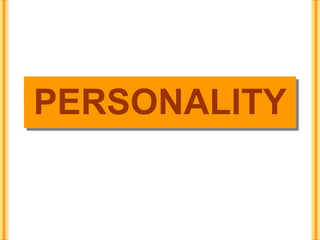Personality
- 1. PERSONALITY
- 2. WHAT WHAT Y T I Personality word is derived from the Latin word persona Personality word is derived from the Latin word persona which means to speak through. which means to speak through. L A Fred Luthan says – Personality mean how a person Fred Luthan says – Personality mean how a person affects other and how he understands and views himself affects other and how he understands and views himself N as well as the other pattern of inner and outer as well as the other pattern of inner and outer measurable traits and the person-situation interaction. O measurable traits and the person-situation interaction. S Personality represent the “whole person”, includes Personality represent the “whole person”, includes perception, learning, motivation. R perception, learning, motivation. E P
- 3. Determinants Determinants Y Biological Factors :: Biological Factors -Heredity – from ancestor to descendant T -Heredity – from ancestor to descendant -Brain – Right brain and left brain imapct on individual -Brain – Right brain and left brain imapct on individual I -Physical feature – External appearance -Physical feature – External appearance L Family and Social Factors :: Family and Social Factors A Influenced by his family and social group Influenced by his family and social group N Situational factor :: Situational factor O Personality may often change in different situation Personality may often change in different situation S Other factors :: Other factors Interest – Having various and different taste makes personality Interest – Having various and different taste makes personality R Character – Primarily means honesty. Esstential to study both Character – Primarily means honesty. Esstential to study both situation and individual for analysing behaviour. E situation and individual for analysing behaviour. P
- 4. Development Development Y T I 1-PSYCHO SEXUAL THEORY (FREUD THEORY) L 1-PSYCHO SEXUAL THEORY (FREUD THEORY) A 2-PSYCHOSOCIAL THEORY OF ERIC ((ERIKSON THEORY) 2-PSYCHOSOCIAL THEORY OF ERIC ERIKSON THEORY) N 3-CHRIS ARGYRIS IMMATURITY ((MATURITY THEORY) 3-CHRIS ARGYRIS IMMATURITY MATURITY THEORY) O S R E P
- 5. 1-PSYCHO SEXUAL THEORY (FREUD THEORY) 1-PSYCHO SEXUAL THEORY (FREUD THEORY) Y This theory is based on notion that man is motivated by an unseen This theory is based on notion that man is motivated by an unseen forces that by conscious and rational thought. T forces that by conscious and rational thought. I It has 33aspect : :ID (pleasure principle), EGO (reality principle), SUPER It has aspect ID (pleasure principle), EGO (reality principle), SUPER EGO (societal and personal norm) EGO (societal and personal norm) L There are 44universal stages of psycho sexual development which are A There are universal stages of psycho sexual development which are decisive in the formation of personality –– decisive in the formation of personality N ORAL (first year of life), ORAL (first year of life), O ANAL (second to third year focus on libidinal energy shift from mouth ANAL (second to third year focus on libidinal energy shift from mouth to anal region), S to anal region), R PHALLIC (focus on sexual gratification shifts to another erogenous PHALLIC (focus on sexual gratification shifts to another erogenous body zone) and body zone) and E GENITAL (adult hood, interest in the opposite sex) GENITAL (adult hood, interest in the opposite sex) P
- 6. Conscious Contact with outside world Y Preconscious Material just T beneath surface of awareness Ego Reality principle Secondary I process thinking Unconscious Superego L Well below Moral surface imperative s Ideals of awareness; A difficult to retrieve Id Pleasure N principle Primary process Primary thinking process Life thinking O and death Reality instincts principle Ego Ideal Libido S Id Ego Superego R Sexual, Pleasure The conscience aggressive principle E urges The executive The selfish P beast
- 7. 2-PSYCHOSOCIAL THEORY OF ERIC ((ERIKSON THEORY) 2-PSYCHOSOCIAL THEORY OF ERIC ERIKSON THEORY) Y Erikson criticized on the sexual and biological factors in the Erikson criticized on the sexual and biological factors in the T developing personality given by freud. developing personality given by freud. I He emphasized more on social factor and gave 8 stages He emphasized more on social factor and gave 8 stages L A Infancy – 1st yrs --trust vs mistrust Infancy – 1st yrs trust vs mistrust Early childhood – 2-3 yrs sense of autonomy Early childhood – 2-3 yrs sense of autonomy N Play Age – 4-6 yrs – creative & imaginative abilities dev Play Age – 4-6 yrs – creative & imaginative abilities dev School Age – 6-12 yrs – may learn new skills / /inferiority O School Age – 6-12 yrs – may learn new skills inferiority Adolescence – sense of identity Adolescence – sense of identity S Young Adulthood – 20’s intimacy vs isolation Young Adulthood – 20’s intimacy vs isolation Adult hood – crises of generatively vs self absorption R Adult hood – crises of generatively vs self absorption Mature hood – sense of wisdom Mature hood – sense of wisdom E P
- 8. 3-CHRIS ARGYRIS IMMATURITY ((MATURITY THEORY) 3-CHRIS ARGYRIS IMMATURITY MATURITY THEORY) Y T Personality of an individual develops along a continuum Personality of an individual develops along a continuum from immaturity as an infant to maturity as an adult. from immaturity as an infant to maturity as an adult. I Based upon latent characteristics Based upon latent characteristics L Identified 7 characteristics A Identified 7 characteristics Passive – Active Passive – Active N Dependence – Independence Dependence – Independence Free way of behaving – Diverse behaviour O Free way of behaving – Diverse behaviour Shallow Interest – Deep Interest Shallow Interest – Deep Interest S Short perspective – Long perspective Short perspective – Long perspective R Subordinate position – Superordinate position Subordinate position – Superordinate position Lack of self awareness – Seld awareness Lack of self awareness – Seld awareness E P
- 9. Thank You Thank You By : Anubha Maurya Trainer – Soft skills and Quality Contact for any query or info at :anubhawalia@gmail.com









